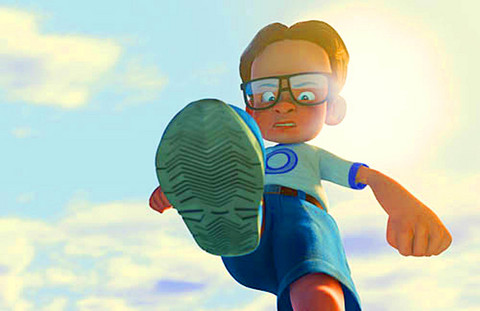The Ant Bully, directed by John A. Davis and based on a book by John Nickle, is the latest computer-animated plea for interspecies understanding. Like Over the Hedge, it asks us to consider that creatures we regard as pests might be people too, or at least that they might speak in the voices of movie stars. Those tiny, six-legged marauders raiding your child's backyard birthday party — what if they were really Nicolas Cage and Julia Roberts? And what if their queen was none other than Meryl Streep? Would you still stomp them, squish them or scorch them with a magnifying glass?
Your answers will remain confidential. In the meantime, while we anticipate the inevitable kiddie-animation extravaganza featuring lovable, anthropomorphized roaches, termites or E. coli bacteria — hey, they have feelings too! — The Ant Bully provides a few moments of inventiveness and wit. Not too many, mind you. The bug theme was big news for Pixar and DreamWorks back in 1998, the year of A Bug's Life and Antz, and this movie, a behind-the-curve effort from Warner Brothers, is unlikely to put either of them in the shade.
The Ant Bully works best when it sticks with the simpler implications of its premise, turning drastic differences of scale and perspective into clever visual jokes. The title character is Lucas Nickle (Zach Tyler Eisen), a picked-on suburban boy who takes revenge on the bullies who bug him by wreaking havoc on the ants who have built their colony on his lawn. In the ant world he is known as the Destroyer, and Zoc, the ant wizard (Cage), devises a potion that will cut this menace down to size. Suddenly, Lucas awakens to find himself a prisoner of the ants, and then, thanks to the intercession of Hova (Roberts), an apprentice ant himself.

PHOTO COURTESY OF WARNER BROS
It turns out that the social insects have much to teach us humans about discipline and cooperation. For them it's all about teamwork, as Zoc explains to Lucas in a quiet, didactic scene. His vision of a society in which every member does his assigned task for the benefit of the group — from each according to his ability, to each according to his need, more or less — strikes Lucas as a stark contrast with the selfish, unfriendly ways of humans. Later he will find a useful application of Zoc's lesson, which he might also have gleaned from watching an old strike movie from the 1930's.
But let's not assume that The Ant Bully is preaching socialism. Coming as they do in the middle of a Time Warner product, Zoc's words are more likely to conjure a bittersweet vision of corporate synergy. If only the various divisions could work together like happy ants, they just might ...
Oh, I don't know. Eat a lot of jellybeans. Its allegorical implications aside, The Ant Bully is a hectic, busy, slapdash entertainment with some inspired visual flights. Among these are the wasps, who hover like attack helicopters, and the slow-moving, ruminant caterpillars who provide delicious food in a rather unappetizing manner. There is the usual assortment of animated-feature supporting characters: vainglorious goofball (Bruce Campbell); sassy, strong woman (Regina King); wise elder (Ricardo Montalban); goofy comic relief (etc.).
The villain is a grotesque exterminator voiced by Paul Giamatti, and the climactic battle against him, though it drags on a bit too long, does have its thrills and surprises. (To appreciate fully the vast disparities between the human and insect points of view, you may want to seek out an IMAX theater, where The Ant Bully will be playing in eye-popping, headache-inducing 3-D.)
In the end, though, The Ant Bully is adequate rather than enchanting. Unsure of its ability to charm, it compensates with noise, sentiment and low humor, the usual synthetic stew served to children — or “pupas,” as the movie calls them.

In the next few months tough decisions will need to be made by the Taiwan People’s Party (TPP) and their pan-blue allies in the Chinese Nationalist Party (KMT). It will reveal just how real their alliance is with actual power at stake. Party founder Ko Wen-je (柯文哲) faced these tough questions, which we explored in part one of this series, “Ko Wen-je, the KMT’s prickly ally,” (Aug. 16, page 12). Ko was open to cooperation, but on his terms. He openly fretted about being “swallowed up” by the KMT, and was keenly aware of the experience of the People’s First Party

Aug. 25 to Aug. 31 Although Mr. Lin (林) had been married to his Japanese wife for a decade, their union was never legally recognized — and even their daughter was officially deemed illegitimate. During the first half of Japanese rule in Taiwan, only marriages between Japanese men and Taiwanese women were valid, unless the Taiwanese husband formally joined a Japanese household. In 1920, Lin took his frustrations directly to the Ministry of Home Affairs: “Since Japan took possession of Taiwan, we have obeyed the government’s directives and committed ourselves to breaking old Qing-era customs. Yet ... our marriages remain unrecognized,

Not long into Mistress Dispeller, a quietly jaw-dropping new documentary from director Elizabeth Lo, the film’s eponymous character lays out her thesis for ridding marriages of troublesome extra lovers. “When someone becomes a mistress,” she says, “it’s because they feel they don’t deserve complete love. She’s the one who needs our help the most.” Wang Zhenxi, a mistress dispeller based in north-central China’s Henan province, is one of a growing number of self-styled professionals who earn a living by intervening in people’s marriages — to “dispel” them of intruders. “I was looking for a love story set in China,” says Lo,

During the Metal Ages, prior to the arrival of the Dutch and Chinese, a great shift took place in indigenous material culture. Glass and agate beads, introduced after 400BC, completely replaced Taiwanese nephrite (jade) as the ornamental materials of choice, anthropologist Liu Jiun-Yu (劉俊昱) of the University of Washington wrote in a 2023 article. He added of the island’s modern indigenous peoples: “They are the descendants of prehistoric Formosans but have no nephrite-using cultures.” Moderns squint at that dynamic era of trade and cultural change through the mutually supporting lenses of later settler-colonialism and imperial power, which treated the indigenous as